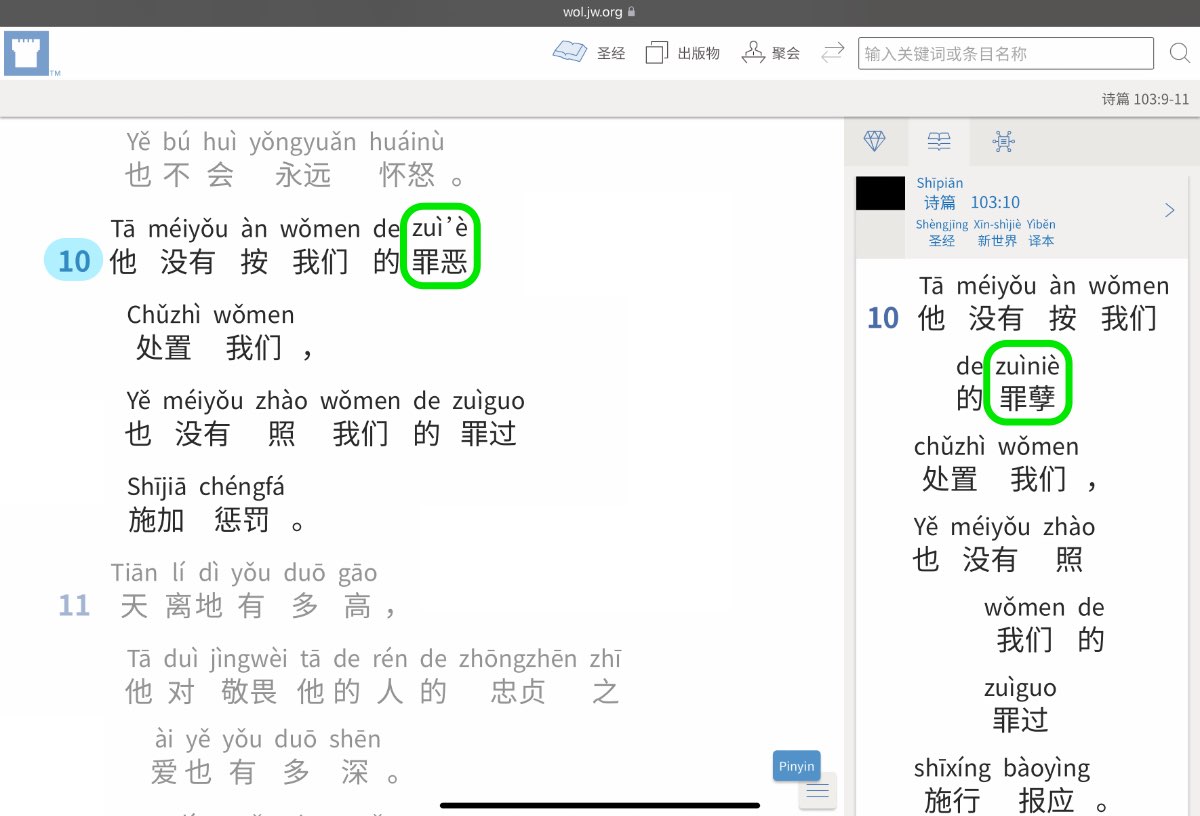shìjiè
(shì·jiè
{generation → [world]} · extent’s → [world’s]
世界)
mòrì
(mò·rì
end · {sun → [day]}
末日)
← Tap/click to show/hide the “flashcard”
[Notes: Tap/click on a Pīnyīn (Pīn·yīn {Piecing Together} · Sounds → [Pinyin] 拼音) expression to reveal its “flashcard”; tap/click on a “flashcard” or its Pīnyīn (Pīn·yīn {Piecing Together} · Sounds → [Pinyin] 拼音) expression to hide the “flashcard”. 📖 📄 📘 icons mean 📖 Reveal All, 📄 Reveal Advanced, and 📘 Reveal None re all the “flashcards” in the heading, paragraph, etc. that they are placed at the beginning of.]
At the time of this writing, jw.org was featuring the article “Politicians Warn of Armageddon—What Does the Bible Say?”. Where the English version of this article uses the word “Armageddon”, the Mandarin version often uses this week’s MEotW, “shìjiè (shì·jiè {generation → [world]} · extent’s → [world’s] 世界) mòrì (mò·rì end · {sun → [day]} 末日)” (which basically means “the end of the world”), with the first occurrence of “Hāmǐjíduōdùn (Armageddon 哈米吉多顿 哈米吉多頓)”, the direct Mandarin translation of “Armageddon”, occurring in parentheses after an occurrence of “shìjiè (shì·jiè {generation → [world]} · extent’s → [world’s] 世界) mòrì (mò·rì end · {sun → [day]} 末日)”.
This shows that the expression “Hāmǐjíduōdùn (Armageddon 哈米吉多顿 哈米吉多頓)” is not considered by the organization to be commonly known by householders in the Mandarin field. The English word “Armageddon”, which refers to something mentioned in the Bible, may be relatively well known in the English-speaking world, but compared to the English-speaking world, the Mandarin-speaking world is significantly less familiar with the Bible and the things mentioned in it.—Revelation 16:14, 16.
[Not taking for granted that Mandarin-speaking people are familiar with the Bible includes not taking for granted that they are familiar with Bible characters and Bible stories. In this regard, some publishers find it helpful to refer their Mandarin-speaking Bible students to publications like the Learn From the Bible (lfb) book. (Mandarin-learning publishers may find it helpful to follow along with the resources at the following links: official CHS+Pīnyīn (Pīn·yīn {Piecing Together} · Sounds → [Pinyin] 拼音) 🔗; unofficial Pīnyīn (Pīn·yīn {Piecing Together} · Sounds → [Pinyin] 拼音) Plus 🔗).]
Related Expressions
The “shì (generation [→ [life; lifetime | world | age; era; epoch]] 世)” in “shìjiè (shì·jiè {generation → [world]} · extent → [world] 世界)” has an original meaning of “generation”, from which is often derived the meaning “world”, since the current generation of people makes up the current world of people. “Dài ({take the place of}; replace; subsitute | replacing; substituting → [acting; substitute | generation [→ [period; era; age]]] 代)”, a past MEotW, is also used to mean “generation”. So, it is no surprise that “shìdài (shì·dài generation · {replacing → [generation]} [→ [generation | generation after generation | period; epoch; era; age]] 世代)”, which could mean “generation”, is a thing. “Shì (generation [→ [life; lifetime | world | age; era; epoch]] 世)” also occurs in past MEotW “shìsú (shì·sú {generation’s → [world’s]} · customs | {(of the) generation → [world]} · secular | {generation → [world]} · {secular (world)} 世俗)”, which is used in 1 Corinthians 3:1 (Mandarin NWT (nwtsty)) to effectively mean “fleshly”, “worldly”, or “secular”.
The “mò (tip; end [→ [last/final stage]] 末)” in “mòrì (mò·rì end · {sun → [day]} 末日)” also appears in “mòqī (mò·qī end · period 末期)”, and indeed, in “mòshì (mò·shì {end of → [last stage/phase of]} · {generation → [world | age; era]} 末世)”. Some who have been in the Mandarin field for a while may also remember the expression “mòhòu (mò·hòu end · last 末后 末後) de (’s 的) rìzi (rì·zi {suns → [days]} · [suf for nouns] 日子)”. However, note that in the current version of the Mandarin New World Translation Bible (nwtsty), this expression has been replaced with “zuìhòu (zuì·hòu most · afterwards → [final] 最后 最後) de (’s 的) shíqī (shí·qī {(particular) time} · period 时期 時期)” in scriptures such as Ezekiel 38:16.

Usage Examples
Here are a couple of examples of “shìjiè (shì·jiè {generation → [world]} · extent’s → [world’s] 世界) mòrì (mò·rì end · {sun → [day]} 末日)” in use, taken from the above-mentioned article:
English:
Politicians [warn] that we may be facing Armageddon.
Mandarin:
📖 📄 📘 Zhèngzhì (Zhèng·zhì political · governing → [political] 政治) lǐngxiù (lǐng·xiù leading · sleeves → [leaders] 领袖 領袖)…fāchū (fā·chū sent · out 发出 發出) jǐnggào (jǐng·gào warning · declarings → [warnings] 警告), shìjiè (shì·jiè {generation → [world]} · extent → [world] 世界) jiāng ({is going to} 将 將) miànlín (miàn·lín {be facing} · {be drawing near to} 面临 面臨) mòrì (mò·rì end · {sun → [day]} 末日).
English:
Will the possible use of nuclear weapons lead to Armageddon? What does the Bible say?
Mandarin:
📖 📄 📘 Shǐyòng (using 使用) hé ({pit (of a fruit)} → [nuclear] 核 核/覈) wǔqì (wǔ·qì military · instruments → [weapons] 武器) huì (will 会 會) dǎozhì (dǎo·zhì lead · {to extend to} 导致 導致) shìjiè (shì·jiè {generation → [world]} · extent’s → [world’s] 世界) mòrì (mò·rì end · {sun → [day]} 末日) ma ([? ptcl for “yes/no” questions] 吗 嗎)? Shèngjīng (Shèng·jīng (the) Holy · Scriptures → [the Bible] 圣经 聖經) zěnme (zěn·me what · [suf] 怎么 怎麼/麽) shuō ({does say} 说 說/説)?
